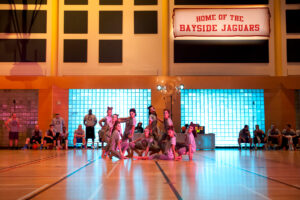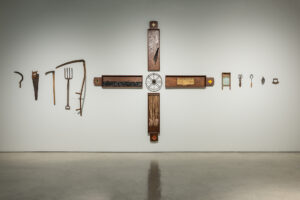Quirky, magical and wondrous, the works of Murray Favro (London) and Marla Hlady (Toronto) in Sweet Dreams and Flying Machines explore the world of sound and flight, and are compelling explorations of the invisible, yet potent power of air.
Amusing and thought-provoking, Hlady’s drawings and kinetic sculptures explore the emotional and experiential terrain of sound. The whirling eddies and meandering lines of her brushed ink drawings render visible the ethereal realm of vibrating sound waves. The exhibition also includes She Moves Through the Fair (Pipe Whistle) (2001), in which a large soundproof box is the starting gate for this audio sculpture. A traditional Irish ballad of the same name – a tale of lost love – plays within, its sound waves squeezing and winding their way through the copper tubes. Her composition calls into the question the relationship between the corporeal and the cerebral, a metaphorical distortion of memory by experience.
Many of Hlady’s creations make room for the viewer’s interaction. Her mixers are activated when the viewers picks them up, engaging sensors that cue their melodic compositions. Visitors are invited to engage, listen and ponder. She describes the sculptures as “insistently functional…whether through the repeated gestures of the kinetics or through the utilitarian objects referenced by forms that support the audio and kinetics.”
Hlady’s recent work, Wah-wah teapot (Landscape for Lavin Lucier) (2006), is created from two teapots on a table with speakers, electronics and microprocessor. The work is a nod to the American composer and sound artist who, with contemporaries such as John Cage, influenced music composition through the late Twentieth Century. An excerpt of Ry Cooder’s slide guitar from the opening scene of the film Paris, Texas can be heard through the lids of the teapots. The guitar phrases cycle from a recognizable melody to a series of fragmented bars before returning to the original composition. The notion of containing sound in a formal device is an idea that recurs throughout her work. While the constructions recall minimalist sculpture, her incorporation of sound and movement gives viewers an aural and visual experience.
In comparison to Hlady’s work, Favro’s variations are insturments of pure noise by design. His widely-known guitar experiments and more recent wind insturments are outgrowths of his jamming and performance activities with the notorious Nihilist Spasm band. Both the concept and activity of the Band are important influences on his work – a practical reason for the creation of his ongoing series of instruments and a holistic approach to artmaking that embodies the Band’s spontaneous soundmaking.
Favro’s instruments of noise suggest an intuitive response to situations and to artmkaing that curator Marie Fleming describes as “a disregard for conventional interpretations or methods, and a seeking of fresh interaction with object and environment.” The instruments are created with equal doses of investigation, into the history and construction of the “musical” devices, and improvisation.
Since the mid-1960s, Favro has made model airplanes, propeller engines, wind tunnels and an array of instruments, with study drawings as the blueprints for his final sculptures. The elaborate preparatory drawings imply a traditional approach to his work, yet his machines and mechanical gadgets have a decidely anti-art aesthetic. Favro’s emphasis on process and performance suggests that his works are fluid and flexible propositions rather than end results.
The works in Sweet Dreams and Flying Machines are fundamentally inquisitve explorations of the mystery and wonder of the intangible: of flight and of sound. In an age dominated by skepticism – where seeing is believing, proof is demanded and the image reigns supreme – Favro’s and Hlady’s works are driven by a curiosity with the world and a desire to unravel its mysteries. Their works engage invention, innovation and ingenuity, providing viewers with an array of fantastical creations in their explorations of the terrain where art and play, magic and science collide.





